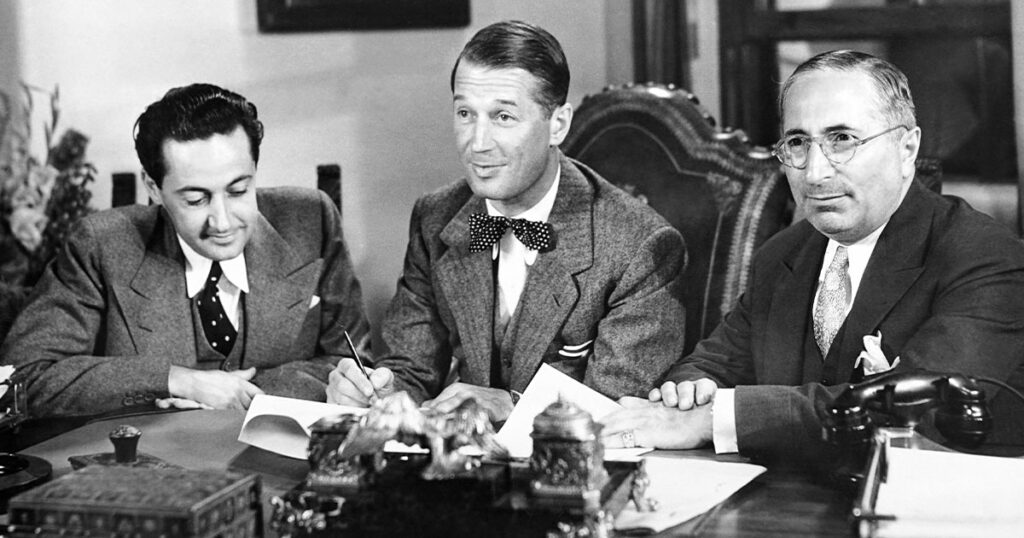In the Lions’ Studio
A new dual biography turns the lens on the towering architects of Metro-Goldwyn-Mayer

Louis B. Mayer and Irving Thalberg: The Whole Equation by Kenneth Turan; Yale University Press, 400 pp., $30
During the high point of Hollywood’s studio era, when motion pictures made their storied transition from silents to talkies, no studio was more glamorous, more lavish, more star-studded than Metro-Goldwyn-Mayer (“more stars than there are in heaven” was its apt motto). It boasted such directorial luminaries as King Vidor, Victor Fleming, George Cukor, and Ernst Lubitsch; its contract writers included Lenore Coffee, Donald Ogden Stewart, Dorothy Parker, and Anita Loos; and its roster of A-listers was seemingly endless—Clark Gable, John Barrymore, Jean Harlow, Greta Garbo, Joan Crawford, Judy Garland, and Fred Astaire were among its brightest talents.
At the helm of it all were two powerful producers: the irascible, relentlessly driven studio patriarch, Louis B. Mayer; and the soft-spoken, considerably younger (yet equally ambitious) vice president and head of production, Irving Thalberg. They are the twin subjects of Los Angeles Times film critic emeritus Kenneth Turan’s engrossing new book, Louis B. Mayer and Irving Thalberg: The Whole Equation. Turan takes his subtitle from a stray passage of F. Scott Fitzgerald’s unfinished novel The Last Tycoon, whose protagonist, the Thalberg-inspired ace studio executive Monroe Stahr, is said to be among the few men in Hollywood who “have ever been able to keep the whole equation of pictures in their heads.” Together, Mayer and Thalberg achieved spectacular commercial and critical success and, as Turan writes, turned MGM into “the standard by which others were judged.”
The two men came from dramatically different backgrounds. Mayer, who was given the name Lazarus at birth, was raised by impoverished East European Jewish immigrants in New Brunswick, Canada, where he left school at the age of 12 to help his father peddle scrap metal. With the money he earned in the family business, he moved to Boston and bought up old theaters, ultimately transitioning into film distribution and production and clawing his way into the picture business (then still in the age of nickelodeons). More than a dozen years later, Thalberg was born to German-Jewish stock in the Bushwick section of Brooklyn, not exactly well-to-do but on the rise. At birth, he was diagnosed with a congenital heart condition called methemoglobinemia (or “blue baby syndrome,” as it was known at the time) and given a predicted life span of 30 years. Bedridden for a stretch during his teens, Thalberg dropped out of high school and headed for Hollywood, where he had the good fortune of being made the personal assistant to Universal Studios boss Carl Laemmle, a German-Jewish émigré known to hire his own.
Their individual reputations in the motion picture business, where the two officially joined forces at MGM for its auspicious launch in 1924, were appropriately distinct. Mayer “was a very impetuous man—given to sudden infatuations, temper outbursts, emotional moments,” remarked producer David Lewis—Mayer’s favorite diet, according to Hermann Mankiewicz, was “his fellow man.” By contrast, owing to his youthful demeanor, Thalberg was frequently mistaken—even by his own future wife, MGM star Norma Shearer—as an office boy. Vogue columnist Allene Talmey described the “boy producer” as “nervous, skinny, mostly dark eyes and no body.” A certain father-son dynamic took hold, replete with oedipal battles and internal clashes. “I can’t make stars as fast as L.B. can fire them,” Thalberg once rued. When, in a textbook case of Hollywood nepotism, Mayer snubbed Thalberg by allowing his son-in-law David O. Selznick to run his own unit, the press tagged the event “The Son-in-Law Also Rises.”
Turan’s account gains momentum as he zeroes in on pivotal episodes in the history of MGM. “One of my chief functions,” Thalberg explained to a group of University of Southern California students in 1929, “is to be an observer and sense and feel the moods of the public.” He and Mayer had an outsize talent for producing box-office hits (from Ben-Hur and Tarzan to The Thin Man), signing domestic and international stars, and for maintaining a near monomaniacal focus on achieving popular success. Turan devotes an entire chapter to Garbo, whom Mayer discovered and Thalberg included in his “multistar pattern,” showcasing her and other MGM leading talents in smash hits like Grand Hotel. “What when drunk, one sees in other women, one sees in Garbo sober,” British critic Kenneth Tynan famously quipped.
By the time that Thalberg died in 1936 at the age of 37, he had managed to outlive his doctors’ predictions without ever compromising his feverish productivity (“He felt it better to die of over work than be bored to death by inactivity,” remarked actress and writer Anita Loos). Mayer did what he could to uphold the legacy of his winning collaboration with Thalberg, overseeing many more cinematic triumphs, inspiring awe in friend and foe, and ultimately witnessing the end of the studio era—he resigned from the company in 1952—before his death in 1957. Both men’s funerals were grand Hollywood affairs, with an army of marquee stars, film professionals, and studio executives in attendance. “It shows you that if you give the public what they want,” joked Billy Wilder (who had cowritten the Lubitsch hit Ninotchka for the studio in 1939), at Mayer’s funeral, “they will come out for it.”
The story that Turan tells over 21 brisk chapters, is rich in anecdote and brimming with old Hollywood lore. Its great virtue, beyond its compulsive readability, is that it widens the scope on its two subjects, incorporating prodigious research—a significant portion of it drawn from the pioneering work by former MGM studio executive Samuel Marx—and spinning a good yarn in the process. “In the end,” observes Turan in the book’s final lines, after citing Amazon’s 2022 acquisition of the studio for $8.5 billion, Thalberg and Mayer’s “drive to create something of value from the flickering shadows that obsessed them succeeded more than they dared imagine. They had dreamed big, bigger than the stars they created, and they likely felt something like astonishment when their dreams came true.”

